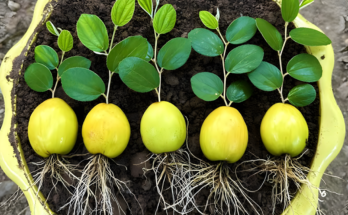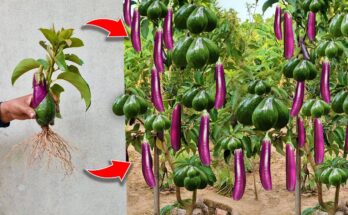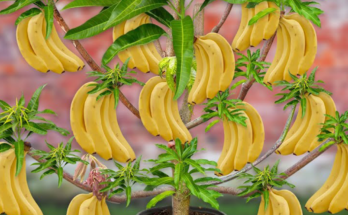New Method for Planting and Growing Hybrid Dragon Fruit Trees with Pineapples
Growing fruits has always been a fascinating practice for farmers and gardeners who seek new ways to cultivate healthy plants and increase yields. In recent years, hybrid planting methods have become more popular, as they allow growers to combine the strengths of two different species. One innovative and unique idea is the method of planting and growing hybrid dragon fruit trees with pineapples. This approach not only offers novelty but also creates an exciting way to blend two tropical favorites into one productive system. Below is a step-by-step explanation of this new method, its benefits, and important tips for success.
Understanding the Plants
Dragon Fruit (Pitaya):
Dragon fruit grows on a climbing cactus that requires strong support to rise upwards. It thrives in warm, sunny climates and prefers well-drained soil. The fruit is highly nutritious, rich in antioxidants, vitamins, and fiber.
Pineapple:
Pineapple is a short, perennial tropical plant that grows close to the ground. It is known for its sweet and tangy taste and its ability to adapt well to sandy or loamy soils. Pineapples require plenty of sunlight and consistent watering.
When these two plants are grown together through hybrid planting methods, they can complement each other in terms of soil use, space efficiency, and even pest resistance.
Step 1: Preparing the Soil
To begin, choose a site with sandy-loam soil that drains well. Both dragon fruit and pineapple dislike waterlogged conditions, so soil preparation is crucial. Mix in organic compost or well-rotted manure to enrich the ground with nutrients. Create slightly raised beds or mounds, which help to keep roots from sitting in water during heavy rains.
Step 2: Designing the Hybrid Planting System
The new method of planting involves pairing dragon fruit with pineapples in the same bed. Here’s how:
- Central Dragon Fruit Posts:
- Install strong wooden or concrete posts vertically, around 1.5–2 meters tall. These will serve as supports for dragon fruit vines.
- Plant dragon fruit cuttings at the base of each post. Over time, the cactus will climb and spread on top.
- Pineapple Ring Planting:
- Around each dragon fruit post, plant a circular ring of pineapples about 40–50 cm from the base.
- Space pineapples 30–40 cm apart to allow room for growth.
- This arrangement creates a multi-layered system where dragon fruit grows vertically, while pineapples cover the ground horizontally.
This design saves space, controls weeds, and provides a natural mulch effect when pineapple leaves overlap.
Step 3: Planting the Cuttings and Crowns
- Dragon Fruit: Use healthy cuttings about 30–40 cm long. Let the cuttings dry in shade for 2–3 days before planting to prevent rot. Insert them upright in soil near the post.
- Pineapple: Plant pineapple crowns (the leafy top of the fruit) or suckers. Insert them into the soil with the base just below the surface.
By planting both at the same time, their root systems will adapt and establish together.
Step 4: Watering and Fertilization
Both plants require regular but moderate watering. Too much water can cause root rot, especially for pineapples. Drip irrigation or light hand watering works best.
For fertilization:
- Apply organic compost every 2–3 months.
- Use a balanced fertilizer high in potassium to encourage fruiting.
- Mulch with dried leaves or straw to retain moisture and suppress weeds.
Step 5: Training and Supporting Dragon Fruit
As the dragon fruit grows, tie its stems gently to the post until they reach the top. Once at the top, allow the stems to droop over, encouraging flowering and fruiting. Pineapples remain at the base, creating a natural ground cover that reduces soil evaporation.
Step 6: Pest and Disease Management
Interestingly, growing dragon fruit with pineapples reduces the spread of pests. Pineapples form a dense ground layer, which makes it harder for weeds to grow. This lessens the chances of pests hiding in undergrowth.
However, you should still check regularly for:
- Mealybugs on dragon fruit stems.
- Fruit borers on pineapples.
- Root rot from overwatering.
Organic neem oil sprays or garlic extract solutions can be used to control pests naturally.
Benefits of This Hybrid Planting Method
- Efficient Use of Space: The vertical-horizontal system allows farmers to grow two crops in the same area without crowding.
- Higher Yields: While dragon fruit produces fruits on posts, pineapples cover the base and produce their own harvests.
- Soil Protection: Pineapple plants protect the soil from erosion and maintain moisture levels.
- Weed Control: Dense pineapple leaves shade the ground, reducing weeds naturally.
- Economic Value: Farmers get two marketable fruits from one system, increasing income potential.
- Aesthetic Appeal: The combination of tall cactus vines with ground pineapples creates a unique and attractive orchard design.
Harvesting
- Dragon Fruit: Usually begins fruiting within 12–18 months after planting. Harvest when the skin color turns bright red or yellow, depending on the variety.
- Pineapple: Takes about 18–24 months to mature. Harvest when the fruit turns golden yellow and gives a sweet aroma.
The exciting part is that both crops can be harvested around the same time, giving farmers double rewards from their hybrid planting.
Conclusion
The new method of planting and growing hybrid dragon fruit trees with pineapples is a creative and effective way to maximize land use, improve yields, and increase sustainability in tropical farming. By combining the vertical growth of dragon fruit with the ground-covering nature of pineapples, growers create a balanced system that conserves resources, controls weeds, and provides multiple harvests. This hybrid planting technique can be practiced in home gardens, small farms, and even larger plantations. With proper care and management, the result is not only an abundant harvest but also a beautiful orchard that stands as a symbol of innovation in agriculture.



